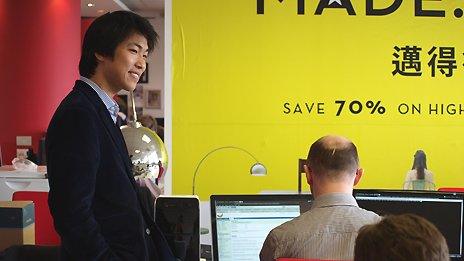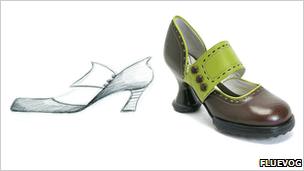Crowdsourcing: Turning customers into creative directors
- Published

Ning Li: "What we think is good for the consumer doesn't matter - it's what the consumer thinks is good that matters."
"The office building doesn't look so good from the outside, we don't need it to, so the rent is lower, but inside it's really nice."
Ning Li is Made.com's 28-year-old CEO, and we are at the company's London office, on the 11th floor of an unremarkable Notting Hill office block.
Made.com is an online-only furniture retailer, so there's no danger that customers will drop by. The company is six months old and already approaching profitability, with revenue doubling month on month, despite relying on word of mouth rather than marketing.

The Union Jack Piggy Bag from Made.com. The company imports 80% of stock from China, and sources 20% in the UK.
But this is a furniture business with no warehouse - and no inventory.
Instead, products are "crowdsourced".
This is how it works. Visitors to the website are encouraged to submit their designs. The best of these are worked up into prototypes, and posted on the website. Registered members of the Made.com community vote. The most popular pieces are then available for pre-order - made in China, shipped by container and delivered directly to buyers from the port.
The designers are paid nothing upfront - but receive 5% royalties on successful designs, which Li maintains is above the industry average.
By going directly to manufacturers in Mr Li's native China, he says the company can offer high-quality furniture at discounts of between 60-70% compared to traditional high street retailers.
"People buy things from very valued brands. They buy from an importer, who buys from an agent, who sources it from elsewhere. Each time a mark-up is added, sometimes it changes hands three to four times."
"You can sell cheap furniture for a cheap price, but that's not a bargain for consumers. The only way to create a bargain is to create quality furniture for a good price.
"How do we do that? When you link the consumer to the manufacturer there are huge areas of opportunity."
Defining crowdsourcing
Crowdsourcing isn't new. Wired magazine's Jeff Howe, who coined the term back in 2006, external, defines it as "the act of taking a job traditionally performed by a designated agent (usually an employee) and outsourcing it to an undefined, generally large group of people in the form of an open call."
Companies who have embraced it include Procter & Gamble. Their Connect + Develop initiative gave birth to the Swiffer range of cleaning products. InnoCentive crowdsources solutions to R&D problems; chipmaker Intel is looking for the home phone of tomorrow; industrial giant GE is offering $100,000 for a green electricity grid, and Crowdspring deals in design.
Crowdsourcing helped mining firm Goldcorp to discover 8m ounces of new gold deposits in 2000.
It's the internet, of course, that makes crowdsourcing possible - on a global scale.
So is turning your customers into both creative director and chief of research the ideal low-cost model for business?
John Winsor is the author of Spark: Be more Innovative through Co-Creation and chief executive of Victors & Spoils, an ad agency built on crowdsourcing principles: "First of all it's a lot cheaper, and secondly you get a lot more diversity of ideas, so those are the big advantages, and the speed - you get hundreds of ideas in a matter of four or five days. Great ideas come from the edges."
But there are pitfalls. "The biggest caveat is the issue of curation. It's great you opening the gates up to everybody - but all of a sudden you're going to get a lot more stuff."
To cope, ever more companies offer to help setting up crowdsourcing solutions. Mr Li, though, feels that the technology doesn't need to be onerous.
"We take very good photos, with a solid, fast website. We have a technical team so everything's been built in-house. The voting section for instance, this kind of feature is very easy to design."

Threadless designers retain rights to their design for anything other than clothing.
"It was just a fun, creative project"
Threadless co-founders Jake Nickell and Jacob DeHart met on an online art forum in 2000, after Nickell won a t-shirt design contest. He started a thread asking people to post designs, the best of which he would print. The designer would get some cash and some free t-shirts. Chicago-based Threadless was born.
Mr Nickell claims that "it wasn't intended to be a business at all, I never really thought it could get big like this. It was just a fun, creative project.
"We later learned that it was this revolutionary business model. I think the reason it's so pure like that is the reason it's worked so well as a crowdsourcing company."
Ten years on the company is highly profitable, bringing in close to $30m in revenue in 2009.
Around 1,200 designs are submitted a week. The best are posted online, where the community votes. The company then decides which of the most popular designs should go into production.
Winning designers get $2,000 plus $500 in vouchers. Should the t-shirt go to a reprint, they get a further $500.
The crowdsourcing model has critics; companies, they say, are simply getting spec work done for free.
Mr Nickel doesn't see Threadless that way: "I think that the way companies are seeing crowdsourcing is a lot different from the way we see it. They are looking at it as this new business model, as a way to outsource your work to an anonymous crowd of people. We're more about giving people something productive to do with their passions."
"What differentiates Threadless is there's no spec."
The technology is also an in-house production. He says "it's simple to make a website like Threadless, it's not so much the software that makes the company, it's the community."
Engaging your audience

The ZaZa, Fluevog's most popular Open Source shoe, from design (left) to finished shoe
Canadian shoe design company Fluevog has been around since the 1970's. In 2002, it started Open Source Footwear, a website where customers - or 'Fluevogers' as they're known - can upload designs. Winning shoes are named after their creator, who also receives a free pair.
So far the company has produced 12 of the designs.
Marketing Director Stephen Bailey says that it has benefits beyond the shoes in terms of customer engagement. "It's an affordable way to be ahead. You're able to see what your customers are thinking and what they're dreaming of, and you're able to measure that against what you're doing."
Fluevog outsources some of the coding of its website, but most of the technology remains in-house. Open source designing has proved so successful, the company has branched out into crowdsourcing print advertising through Fluevog Creative.
'Design by committee'
Not everyone is so sanguine about the benefits. Jaron Lanier is a US computer scientist, virtual reality pioneer, and author of You Are Not a Gadget. He made Time magazine's 2010 list of the world's 100 most influential people.
His concern is that by "mining" the crowd in this way, the wealth that results from the work done remains concentrated in the hands of the people who put out the call - ultimately endangering jobs and the economy. Mr Lanier also believes that crowdsourcing threatens creativity.
"The wisdom of crowds is what we call in the trade an optimising function, meaning that if you can set up a problem where you just want a simple answer. Crowdsourcing is good at that but for synthetic creation there just aren't any examples of it being good - it leads to what we call design by committee, dull derivative stuff.
"Do you really think that Simon Cowell would have promoted the Beatles through some show where the crowd was voting? ... Of course not."
Despite this, use of crowdsourcing as a low-cost means of innovation seems unlikely to disappear.
Made.com's Ning Li says, "I can't imagine any business doing what we're doing with a lower cost structure. The model's been proven - we're selling one container a day of products which for a six-month business is absolutely fantastic.
"I think the features for crowdsourcing are not very complicated to develop. What's complicated really is to keep your promise. Because consumers can like something but eventually if you don't do anything about it, it's frustrating and disappointing for people who trust you with their votes."
- Published3 June 2010